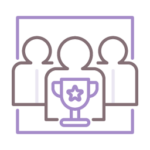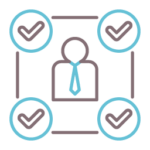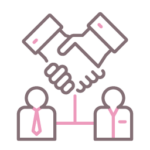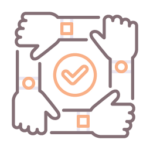Advanced Graphics Customisation
Gamification in business: improving employee engagement through play

Gamification is a popular approach for making client experiences more enticing and amusing, but it is also applicable in the world of work and business to reward and nurture employees. Introducing games and gamification can be done to improve employee morale, improve employee performance through training, and aims to promote employee loyalty. By turning processes and training into gamified content, engagement levels and user focus increase as typically less playful tasks are made fun and rewarding.
When working remotely, or delivering training remotely and in the office alike, internal gamification as part of your human resources (HR) strategy can promote loyalty, productivity, motivation, and engagement among employees.
The quality of the gaming experience in the workplace will be the main element improving employee engagement. Here is how you can utilise gamification and its various mechanisms to the benefit of your employees by gamifying your workplace.
Making games successful in the workplace

The key to the success of gamification in the workplace is to know what you hope to achieve by introducing it. Listen to the needs and incentives of your employees to find suitable games and reward systems to put in place in your gamification process. You need to make sure you have the right game mechanics in place to be able to provide the appropriate challenge, feedback, and recognition to make your gamified experiences effective. Some people easily adapt to the change, while other people can be more reluctant to accept something new.
The best way to introduce gamification is to start with something your employees will find easy to use, which is fun and entertaining for everyone. This generates interest and motivates people, which in turn makes them want to participate and compete. The set-up must let people see that the game is a positive and rewarding progression and that it will have a positive impact on their daily professional lives. It is also important to have a clear, more long-term plan in terms of profiling, and using the gamified content for future career development.
If the business can convincingly communicate that the experience will be enriching and that it will motivate individuals and the team as a whole, then the experience will have more chance of succeeding at increasing engagement levels. There must be a clear and tangible advantage for the organisation and the individuals who will ultimately become users or players. Once the team has embraced the idea, and an activity or two has been completed, look for feedback so that your employees can share their learnings and thoughts – again, even this part can be done in-game by customising a Survey specific to the first iterations of your gamified experience. After multiple days of usage, analyse the collected data to bring to light what has worked well (or not so well), and make improvements if necessary. By keeping these basic tips in mind when designing your business gamification project, you are sure to achieve your goals.
Concrete gamification best practices for employee engagement
Now let’s look at how gamification can be applied in an efficient and practical manner in the workplace. Let’s consider how it can be used to improve internal communication, training, employee integration, as well as business satisfaction.
1. Employee welcome and retention

After the recruitment phase for new employees joining your business, games can be used in the onboarding process to help new recruits to get to know their team, form connections with their colleagues, familiarise themselves with the business’s culture, and fill in the gaps in terms of skills to settle in more quickly. New employees are generally apprehensive when they arrive in a new organisation and it takes them time to settle in. A gamified welcome programme for new colleagues with our Dynamic Path™ format allows you to reduce the stress and anxiety associated with a new job and to improve the employee morale. You can use the playful experience to not only engage them in relevant company matters, but to make them feel at ease in their new surroundings. It helps you make the first days of work a bit easier to manage and to keep people motivated and engaged.
By helping new employees settle in more quickly, you not only help to integrate them more efficiently, but you also help to decrease employee turnover rates. Gamification is a good way to encourage new employees to complete their first missions, provide them with constructive feedback and recognition, and for the business to communicate with its employees after the recruitment process. It gives them a feeling of motivation, personal satisfaction, and accomplishment.
2. Improve skill development and productivity

The saying goes, do what you love, and you’ll never work a day in your life. The more fun we have, the less it feels like working. That’s just a fact. When it comes to gamification, students learn more effectively through games than through traditional training, and improving skills results in more productive teams. If you make skill development a game to your employees, it can bring out the competitive streaks, and the motivation to beat their peers. Conversely, you might design a serious game with the intent of fostering teamwork, and encouraging employees to work together, by appealing to their desires for social discovery and sharing.
Using gamification experiences to train employees allows you to reduce the time required for implementation in company matters, which means that as well as developing relevant skills in your teams, you will achieve satisfying results that directly benefit your business more quickly.
A customised Quiz based on work-specific topics can help to quantify employees’ learning, and show the areas which may require further training. Gamified training allows you to introduce rewards for achieving fixed key performance indicators (KPIs), whether it is digital rewards such as points and badges, or material rewards such as gift cards or salary bonuses. Such recognition and positive feedback is essential to gamified content aimed at sharpening skills and promoting increased productivity.
3. Share knowledge between colleagues

Gamification can be used to create a mentoring culture, by improving cooperation between teams and different members of departments who have varied skills and experiences. Cross-functional teams are essential for coordination and efficiency, but it is an area which many organisations struggle with.
Gamification can be used to create a standardised system to share knowledge, while encouraging teams to work together by helping different departments to interact and understand each other better. It is a question of bringing teams together to create company-wide unification. It can take the form of a question and answer forum, using an app about the business’s culture, publishing blog posts, or completing gamified missions to earn rewards.
4. Promote group cohesion and team spirit

Gamification in business is also emerging as a pertinent internal digital communication tool for team building and maintaining a corporate culture. By bringing all employees together through an engaging, fun, and innovative medium, gamification creates new connections within teams and aims to strengthen the collective team. Businesses can use gamification to promote internal communication channels, even when they are working from home. When working remotely, new participatory and engaging interactions help to maintain team cohesion. Additionally, by gamifying processes, employees are able to remain more focused on their work, as traditionally tedious tasks become fun thanks to games.
Gamification at work can also help managers to develop technical skills and soft skills within their team. Working together to carry out a project or achieve a goal during a team building exercise, for example, is an excellent gamification and engagement opportunity. When playing a game, formalities subside and people relax, which gives managers an unfiltered view into an employee’s capability to process information, strategise, and interact with their peers.
Implementing a game programme at different levels within a business at the level of daily tasks can serve to introduce sustainable changes in the workplace which everyone can be involved in. For example, it can be focused on ecological initiatives, and include a reward system for recycling and energy savings over a defined time period.
Want to know more?



